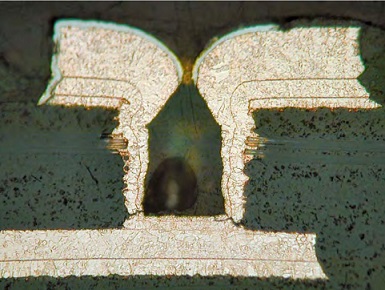Defect Description
Barrel cracks are usually found with a taper towards the base of a microvia that are prone to propagation upon the exposure to environmental stresses.
Defect Formation Process(s)
Main cause for most plating problems are related to a dysfunctional combination of chemistry and equipment. It is found that PWB manufacturers use different suppliers for various chemical components within the metallization line; this can create chemical incompatibilities between critical preparation steps (cleaning, desmearing, micro-etching, glass-fibre etching, conditioning, activation, etc.)
|
List of Tests to Precipitate this Defect |
Failure Acceleration |
Likihood to Precipitate Defect (condition) |
Failure Mechanism(s) |
|
Thermal Shock |
• Cyclic thermal mechanical stress accelerates crack growth due to the local stress concentration • Thermal mechanical stress causes fracture of the copper plating at the cracks where local stress concentration is high |
✔ |
Thermal Fatigue Thermal Mechanical Overstress |
|
Random Vibration (RS/ED) |
• Random Vibration accelerates crack growth due to the local stress concentration • Vibration causes fracture of the copper plating at the cracks where local stress concentration is high |
✔/✇ |
Mechanical Fatigue Mechanical Overstress |
|
Combined Environment |
• Combination of Thermal Shock and Random Vibration |
✔ |
Combination of Thermal Shock and Random Vibration |
|
Bend Test |
• Bending can cause fracture of the copper plating at the cracks where local stress concentration is high |
✇ (Defect at a location with significant strain due to bending) |
Mechanical Overstress |

References
Top